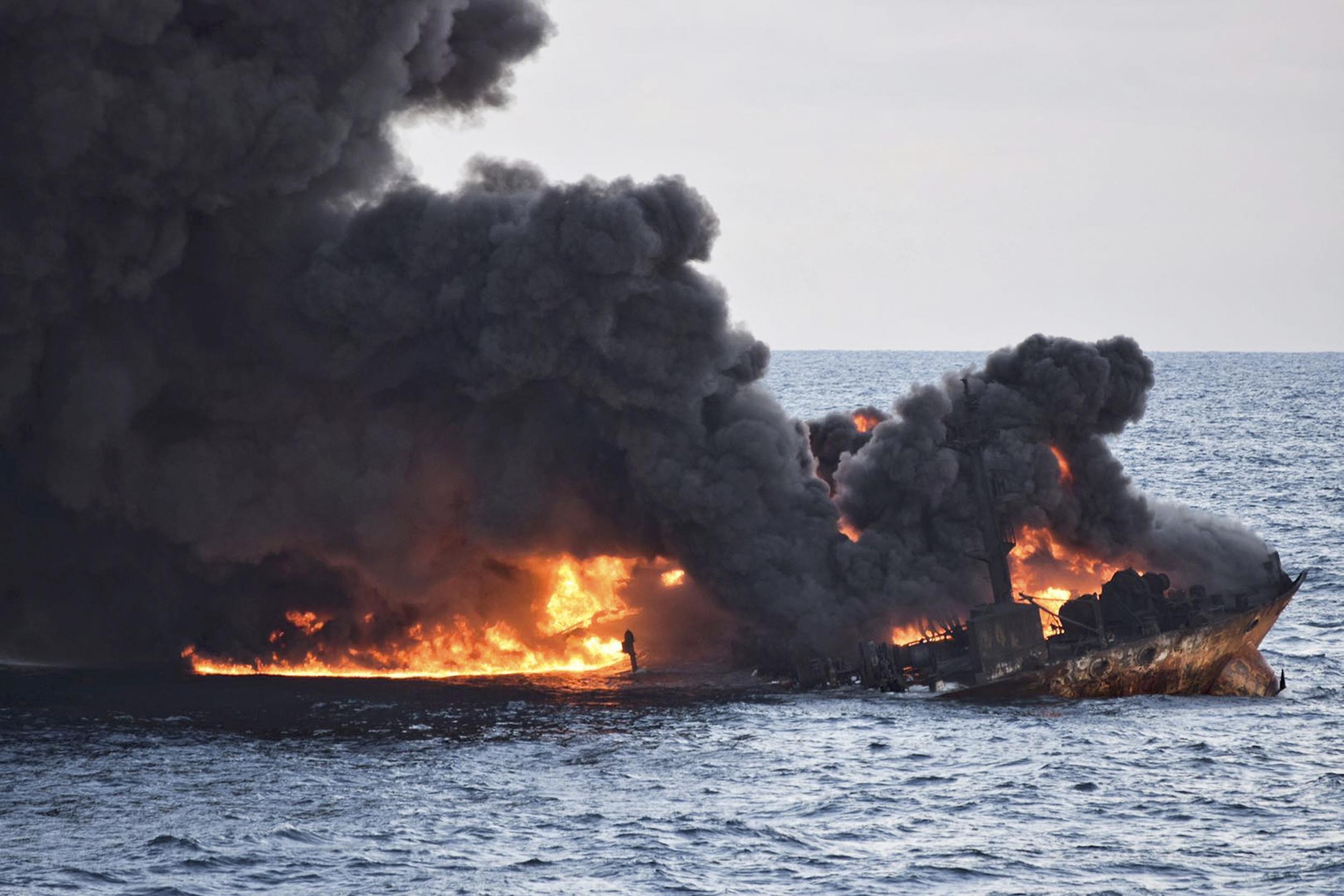Burning Iranian tanker produces 10-mile oil slick in East China Sea that threatens marine life
Sinking vessel could harm rich array of fish and birds found in nearby waters

Your support helps us to tell the story
From reproductive rights to climate change to Big Tech, The Independent is on the ground when the story is developing. Whether it's investigating the financials of Elon Musk's pro-Trump PAC or producing our latest documentary, 'The A Word', which shines a light on the American women fighting for reproductive rights, we know how important it is to parse out the facts from the messaging.
At such a critical moment in US history, we need reporters on the ground. Your donation allows us to keep sending journalists to speak to both sides of the story.
The Independent is trusted by Americans across the entire political spectrum. And unlike many other quality news outlets, we choose not to lock Americans out of our reporting and analysis with paywalls. We believe quality journalism should be available to everyone, paid for by those who can afford it.
Your support makes all the difference.A burning Iranian oil tanker that sank in the East China Sea could pose a serious threat to the marine environment, according to experts.
The incident has resulted in a 10-mile long oil slick, which was discovered east of the site where the ship sank.
Chinese state TV CCTV said the slick was 1 to 4 nautical miles wide and had grown several times in size since the ship sank on Sunday.
Concerns have been raised about damage to the regional marine ecosystem, which is rich in fish and bird life.
The sinking marks the biggest tanker spill since 1991, when 260,000 tonnes of oil leaked off the Angolan coast.
A clean-up effort on the sea’s surface has begun and rescue teams have called a halt to the large-scale search for survivors, reducing it to “normal” operations, CCTV said.
The blazing vessel, which was carrying 136,000 tonnes – almost one million barrels – of condensate, an ultra-light, highly flammable crude oil, sank after several explosions weakened the hull.
The tanker Sanchi had been adrift and ablaze after crashing into the freighter CF Crystal on 6 January.
Experts worry the ship’s sinking is potentially more damaging to the marine ecosystem than letting the condensate oil burn off.
The sinking will likely expel the remaining condensate and the tanker’s bunker fuel, or the heavy fuel oil that powers a ship’s engines, contaminating the surrounding waters.
Bunker fuel is the dirtiest kind of oil, extremely toxic when spilled, though less explosive. Condensate is poisonous to marine organisms.
The Sanchi may have been carrying about 1,000 tonnes of bunker fuel by the time it hit the grain freighter CF Crystal, according to bunker fuel traders’ estimates.
A harmful plume of condensate would likely be in the water, out of sight of observers on the surface, said Rick Steiner, a US marine scientist based in Anchorage, Alaska, who has experience of oil spills.
“As with all major oil spills, time is of the essence. This is particularly so with condensate spills, as the substance is so toxic and volatile,” said Steiner.
The East China Sea is known for its rich, although already polluted, marine ecosystem, with whales, porpoises, seabirds and fish, he said.
Fuel oil is relatively easy to contain because volumes are lower and its viscosity means it’s easier to extract from water, but even small volumes can harm marine life.
Strong winds have pushed the tanker away from the Chinese coast, where the incident happened, and into Japan’s exclusive economic zone.
China’s State Oceanic Administration said on Sunday that because the explosions had ruptured the hull of the ship, a large amount of oil in surrounding waters was on fire.
Black smoke was still billowing from the site of the sinking, the Japan Coast Guard said on Monday.
The service sent two patrol boats and an aeroplane to the area to search for missing crew members and assess the latest situation, a spokesman for the Coast Guard said.
A Chinese salvage team on Saturday recovered two bodies from the tanker, China’s state news agency Xinhua reported.
Another body, presumed to be one of the Sanchi’s sailors, was found on 8 January and taken to Shanghai for identification.
The salvage team recovered the Sanchi’s voyage data recorder, or “black box” from the bridge of the tanker, Xinhua also said on Saturday. But the team was forced to leave the ship after just half an hour because the wind shifted and “thick toxic smoke” had complicated the operation.
Iranian officials said on Sunday the remaining 29 crew members and passengers of the tanker were presumed dead. The crew consisted of 30 Iranians and two Bangladeshis.
Additional reporting by Reuters.
Join our commenting forum
Join thought-provoking conversations, follow other Independent readers and see their replies
Comments